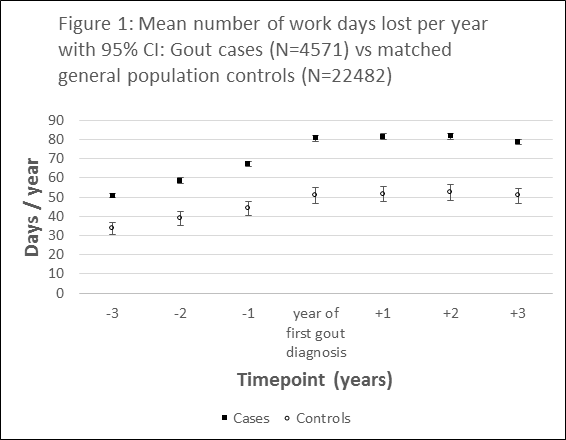Session Information
Date: Sunday, November 13, 2016
Title: Metabolic and Crystal Arthropathies - Poster I: Clinical Practice
Session Type: ACR Poster Session A
Session Time: 9:00AM-11:00AM
Background/Purpose: Gout is the most common form of inflammatory arthritis with a prevalence of 1.5% in our area in the age group 50-59 years. Gout has a substantial association with several comorbidities. Studies on the impact of gout on indirect costs on a population level are however scarce. The aim of the present study was therefore to describe the yearly difference in absenteeism due to sick leave (SL) and disability pension (DP) in patients with gout and matched population based controls.
Methods: Gout cases were defined in the population based health care database (VEGA) of the Western Swedish Health Care Region (WSHCR) by having a first diagnosis of gout in the years 2003-2009 by ICD-10 codes (M10 and M14.0) in VEGA. Cases were included if their age at the time of the first diagnosis of gout was ≤62 years, to allow for a follow-up period of 3 years before reaching the retirement age of 65 years. Five controls for each case, matched for age, sex and place of residence were chosen from the census register by Statistics Sweden. Data on predefined comorbidities registered previous to the index year was collected from VEGA by ICD-10 codes for cases and controls. Yearly net days of SL and DP for cases and controls were retrieved from Statistics Sweden for a period of 3 years before and after the index year. The difference between cases and controls in yearly net days lost from work due to SL and DP were calculated in the whole population, with a subanalysis of those without predefined comorbidities. Mean values with 95% CI for SL and DP days for the gout cases and controls were calculated by ANOVA, accounting for the matched design and applying non-parametric bootstrapping to calculate confidence intervals.
Results: 4571 gout cases were matched to 22482 population controls. The median age at diagnosis of gout was 53 years and 77% of the study group was male. The total number of work days lost was significantly higher for gout cases compared to the general population at the time of gout diagnosis as well as in the years preceding and following the gout diagnosis. Gout patients were absent from work on average 71 days per year while controls were absent on average 46 days per year (figure 1). In a subgroup analysis of 2546 cases and 10157 matched controls without predefined comorbidities this difference remained but was less pronounced (44 vs 31 days) (figure 2).
Conclusion: Work days lost due to SL and DP were substantially higher in patients with gout compared to controls in a population based setting. Comorbidities explained only slightly more than half of this increase suggesting that socioeconomic or other factors closely related to gout are of importance.
To cite this abstract in AMA style:
Sigurdardottir VR, Jacobsson LT, Drivelegka P, Svärd A, Dehlin M. Sick Leave and Disability Pension in Working-Age Gout Patients before and after Diagnosis – a Population Based Case-Control Study [abstract]. Arthritis Rheumatol. 2016; 68 (suppl 10). https://acrabstracts.org/abstract/sick-leave-and-disability-pension-in-working-age-gout-patients-before-and-after-diagnosis-a-population-based-case-control-study/. Accessed .« Back to 2016 ACR/ARHP Annual Meeting
ACR Meeting Abstracts - https://acrabstracts.org/abstract/sick-leave-and-disability-pension-in-working-age-gout-patients-before-and-after-diagnosis-a-population-based-case-control-study/


